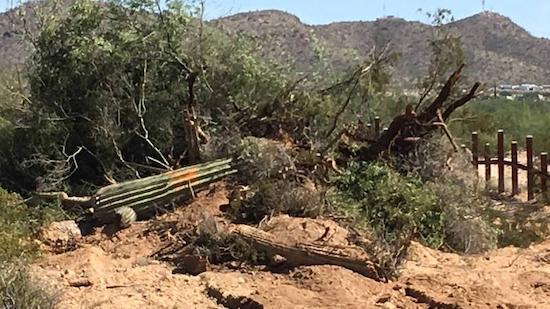
A commercial spaceport proposed to be built just west of Cumberland Island National Seashore poses risks to the seashore's natural, cultural, and historic resources, maintain critics/NPS file
External Threats To The Parks
By Kurt Repanshek
The Rockets' Red Glare
Imagine spending a few nights in the backcountry of a national park, and you're awakened in your tent by the sound of a rocket soaring over your camp. Or, worse yet, the rocket launch ends in failure and the debris showers down on the park.
Cumberland Island National Seashore on the coast of Georgia just happens to be in the flight path of a commercial spaceport the Camden County Board of Commissioners is trying to gain Federal Aviation Administration approval to build 4-5 miles west of the national seashore. While the FAA was expected to release its final Environmental Impact Statement just about a year ago, the process was paused while the county revised its proposal.
The national seashore is rich in human history, and features settings attractive to both birdlife and loggerhead sea turtles. It embraces dense maritime forests and ecologically vital salt marshes, and claims nearly 10,000 acres of officially designated wilderness.
Accessible only by boat, the national seashore features unspoiled beaches and dunes, marshes, and freshwater lakes, along with historic sites. Twisting live oaks covered in resurrection ferns and spanish moss make up the island's maritime forest, shading an understory of sable palms and palmettos. Facing the mainland, the island gazes across mudflats during low tide and swaying marshes.
Concerned onlookers, which range from the National Park Service to private landowners on Little Cumberland Island at the northern end of the national seashore as well as Camden County taxpayers who see the spaceport as a tremendous waste of taxpayer dollars, have a range of fears.
There's the possibility of rockets failing in launch and crashing down on the seashore or Little Cumberland Island; air quality concerns; noise pollution; hazardous wastes; and logistical impacts to the seashore staff.

The trajectory cone contained in the draft EIS shows how much of the national seashore would lie beneath the path of rockets/FAA
With the flight path passing over the seashore's wilderness area, would backcountry travelers have to be banned during launch windows? What would the Park Service's responsibility be in terms of keeping people out of the area below the flight path? How would the seashore be impacted by "a catastrophic failure"?
"Such a failure or mishap could have long-term effects on the island, potential impairment to the island's natural and cultural resources, and major consequences for enjoyment of the island by future generations," the Park Service said in its initial comments to the proposal, a list that ran to nearly three dozen concerns.
Among the concerns was whether launches would adversely impact wildlife. Cumberland Island is home to 22 animal species that listed on either federal or state protected species lists, according to the Park Service, and contains critical nesting habitat for some.
"Early evaluations by the FAA suggest there will be no effect on park resources, however the NPS will independently assess and plan for mitigation once the Final EIS is available," Park Service officials said.
Emily Jones, the acting Southeast regional director for the National Parks Conservation Association, said the FEIS could come out in the near future. That said, she's not convinced the FAA did a thorough job in vetting the proposal.
"This environmental statement will come out without following FAA regulations, or (the National Environmental Policy Act)," she charged. "There is no public comment period in there, there is increased risk of rocket launch failures because they're going from medium rockets (in the first proposal) to small rockets, which are pretty untested. Our concerns remain the same around closures to the national park. Fire is a huge, huge concern, and the impacts of course to the environment."
A taxpayers group that formed in opposition to the spaceport maintains that more than $9 million has been "wasted" on it so far. Among the documents it has posted on its Facebook page is an "Alert" from Boca Chica, Texas, where residents were told to stay out of their homes during a recent commercial SpaceX rocket test.
"There is a risk that a malfunction of the SpaceX vehicle during these activities will create an overpressure event that can break windows," read the alert. "Therefore, in order to protect Public Health and Safety, it is recommended that you consider temporarily vacating yourself, other occupants, and pets, from the area during the Space Flight Activities.
"At a minimum, you must exit your home or structure and be outside of any building on your property when you hear the police sirens, which will be activated at the time of the Space Flight Activity, to avoid or minimize the risk of injury."
That SpaceX prototype test, while deemed a success by SpaceX CEO Elon Musk, ended with the rocket exploding in a massive fireball on landing.

Construction of the border wall through Organ Pipe Cactus National Monument was not light on the land/NPCA, Kevin Dahl
Walling Off The Border
A year ago, Organ Pipe Cactus National Monument on the Arizona-Mexico border landed on Traveler's list of Threatened and Endangered Parks because of construction of a towering wall through the monument with hopes it would stop, or at least impede, cross-border traffic. The monument remains on the list because of that ongoing construction and the impacts its had to park natural and cultural resources, as well as to the visitor experience.
"The wall construction at Organ Pipe, which included scraping the entire length of its 30-mile southern border, is a scar that will take centuries to heal. It cuts off wild desert habitat in the monument with wild desert habitat to the south – almost completely," said Kevin Dahl, the National Parks Conservation Association's senior program manager in Arizona. "The plan to light it all night means it will not only be visible from the park’s campground during the day, but will be a bright line across the horizon, interfering with night sky viewing and bat migration.
"The new administration must empower the Park Service to take leadership in working with the Department of Homeland Security to immediately modify the wall at places, especially important for wildlife, such as access to Quitobaquito Pond and important washes (that are likely to flood and blow the wall anyway)," he added. "In addition, steps must be taken to heal areas important to the O’odham, who were rightfully horrified to see culturally sensitive areas bulldozed and blown up. Their involvement in doing this would be crucial. It is amazing to me that we spent so much money building this monumentally destructive edifice which is so damaging to the monument, when existing infrastructure and Border Patrol operations had been already been doing a fine job of control."

Saguaro cacti were pushed out of the way for the wall's construction/NPCA, Kevin Dahl
At the Coalition to Protect America's National Parks, Chair Phil Francis said the wall's construction was a thumb in the eye to the National Park Service Organic Act.
"Back in 1916, the Congress passed the Organic Act for the creation of the best idea America ever had - the creation of a system of national parks," said Francis. "The Congress was clear that the National Park Service was to 'conserve the scenerary and the life therein by such means and in such manner as to leave the parks protected for future generations.' These instructions were meant for the Executive Branch to follow.
"Sadly, for political reasons, the current administration is allowing significant damage to parks. One good example is what is happening at Organ Pipe Cactus National Monument, as resources are being damaged with little or no regard for their protection," he continued. "This should stop now. I ask the owners of these special places, the American people, to stand up and help save these places like Organ Pipe Cactus. It seems clear that this administration is trying to damage all it can before January 20th."
Threatened Parks:
Cumberland Island National Seashore, Georgia
Endangered Parks:
Organ Pipe Cactus National Monument, Arizona

Add comment